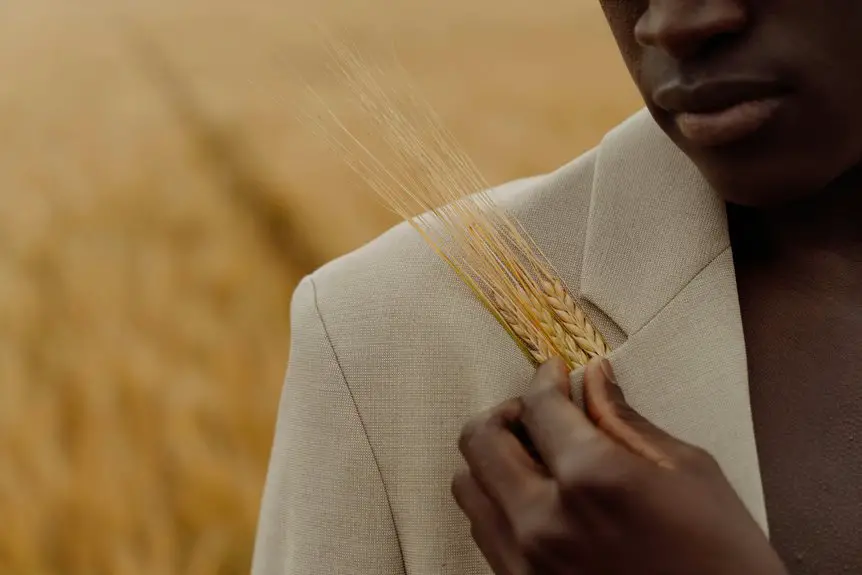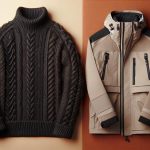You’ll want to wear corduroy mainly in fall and winter since its warmth and textured ribs trap heat perfectly for cooler days. Opt for mid- to heavyweight corduroy paired with sweaters and coats during those seasons. In spring and summer, choose lightweight, fine-wale corduroy or cotton blends to stay breathable and comfy. Stick to darker, classic colors for formal settings and casual hues for laid-back looks. Keep going to discover how to style and care for corduroy year-round.
Table of Contents
Key Takeaways
- Corduroy is ideal for fall and winter due to its warmth, textured surface, and suitability with earth tones and layered outfits.
- Choose mid-weight corduroy for fall’s fluctuating temperatures and pair with chunky sweaters for a cozy look.
- Lightweight, thin-wale corduroy works well in spring and summer, offering breathability without overheating.
- Darker, finer wale corduroy in navy or deep brown fits formal settings when paired with dress shirts and blazers.
- Classic colors like navy, olive, and camel brown ensure versatility across seasons and occasions.
Understanding Corduroy Fabric and Its Characteristics
Corduroy stands out for its unique texture, made up of parallel ridges called wales. When you touch it, you’ll notice this soft, raised pattern that gives the fabric depth and character.
The number of wales per inch varies, affecting its appearance—more wales mean a finer texture, while fewer create a chunkier look. Corduroy is typically made from cotton or a cotton blend, making it durable yet comfortable.
You’ll find it in various weights, which influences how warm or breathable it feels. Because of its sturdy weave, corduroy resists wrinkles and wears well over time.
When you pick corduroy, you’re choosing a fabric that combines texture, strength, and a casual vibe that’s hard to match with other materials.
Corduroy for Fall: Embracing Warmth and Texture
As temperatures drop and leaves change, you’ll find that corduroy offers the perfect blend of warmth and texture to complement fall’s cozy vibe.
This fabric’s soft, ribbed surface traps heat, making it ideal for crisp autumn days. When you wear corduroy in fall, you embrace both comfort and style effortlessly.
Consider these tips to make the most of corduroy this season:
- Opt for earth tones like rust, olive, or mustard to echo fall’s palette.
- Pair corduroy pants or skirts with chunky sweaters for a balanced look.
- Choose mid-weight corduroy for versatility—warm enough for cool days but breathable as temperatures fluctuate.
Styling Corduroy in Winter: Layering and Color Choices
When the chill of winter sets in, you’ll want to rethink how you wear corduroy to stay warm without sacrificing style.
Start by layering your corduroy pieces with cozy sweaters, thermal shirts, or flannel tops. Adding a wool coat or quilted jacket on top enhances both insulation and texture contrast.
Stick to deeper, richer colors like burgundy, forest green, navy, and chocolate brown—they complement the season and elevate corduroy’s natural warmth.
Choose rich hues like burgundy, forest green, navy, and chocolate brown to enhance corduroy’s cozy winter vibe.
Don’t shy away from mixing tones; pairing dark corduroy pants with a lighter knit or vice versa creates visual interest.
Finish your look with winter accessories like scarves and leather boots to balance comfort and sophistication.
With these layering and color choices, you’ll make corduroy your go-to fabric all winter long.
Lightweight Corduroy Options for Spring
You can enjoy corduroy even as the weather warms by choosing lighter fabrics designed for spring.
Look for thin-wale corduroy that keeps the texture without the weight.
Pair these pieces with breathable layers to keep your outfit fresh and comfortable.
Spring-Friendly Corduroy Fabrics
Although corduroy is often linked with cooler weather, you can still enjoy its textured charm in spring by choosing lightweight options. These fabrics keep you comfortable without sacrificing style.
When selecting spring-friendly corduroy, focus on:
- Cotton blends: They offer breathability and softness, perfect for mild temperatures.
- Fine wale corduroy: With narrower ridges, it feels lighter and less bulky.
- Lightweight weight ratings: Look for fabrics under 8 oz per square yard to avoid overheating.
These choices let you embrace corduroy’s unique texture while staying cool during spring’s unpredictable weather.
Styling Lightweight Corduroy
Since spring calls for lighter layers, styling lightweight corduroy lets you balance comfort with texture effortlessly.
Opt for pieces like thin corduroy shirts or cropped jackets to keep your look fresh without overheating. Pair a lightweight corduroy shirt with slim jeans or chinos for casual days, or tuck it into a flowy skirt to add subtle warmth and interest.
For pants, choose lighter-weight corduroy in pastel or neutral tones to complement spring’s softer palette. Layer with breathable tees or tank tops underneath, so you can adjust as temperatures change.
Don’t forget to roll up sleeves or pant hems to enhance the casual, breathable vibe. With lightweight corduroy, you get all the tactile charm of the fabric without feeling weighed down during spring’s milder weather.
Can You Wear Corduroy in Summer? Tips for Hot Weather
You might wonder if corduroy works when the temperature rises.
While traditional corduroy can feel heavy, choosing lightweight versions makes a big difference.
Let’s explore how to keep cool and stylish in corduroy during summer.
Corduroy Fabric Breathability
Corduroy’s thick texture and raised ridges often make people wonder if it’s suitable for summer wear. While it’s not as breathable as lighter fabrics, you can still wear corduroy comfortably in warmer weather if you understand its breathability limits.
The fabric traps heat more than cotton or linen, which might make you feel warmer. However, factors like weave and thickness play a role.
Keep these breathability tips in mind:
- Thicker corduroy holds heat and reduces airflow, which can be uncomfortable on hot days.
- The raised ribs can trap sweat, so moisture-wicking underlayers help you stay dry.
- Airflow is limited, so choose times and places with a breeze or shade.
Understanding this helps you wear corduroy without overheating.
Choosing Lightweight Corduroy
Although corduroy is often seen as a winter fabric, selecting a lightweight version can make it surprisingly suitable for summer. When choosing lightweight corduroy, focus on the wale size, fabric weight, and fiber content to guarantee comfort in hot weather. Thin, fine wales and lower fabric weight allow better breathability and less heat retention. Cotton blends with linen or silk can also enhance airflow. Here’s a quick guide:
| Feature | Summer Corduroy Choice | Why It Works |
|---|---|---|
| Wale Size | Fine (8-12 wales/in) | Thinner ribs, lighter |
| Fabric Weight | 6-8 oz/yd² | Less dense, more breathable |
| Fiber Content | Cotton-linen blends | Improved moisture wicking |
| Weave Density | Loose | Better airflow |
With these tips, you can stay cool while enjoying corduroy in the heat.
Styling Corduroy for Summer
Selecting the right lightweight corduroy sets the stage for wearing this fabric comfortably in summer. You want to pick pieces with a fine wale and breathable weave to avoid overheating.
When styling corduroy for warmer months, keep these tips in mind:
- Opt for lighter shades like beige, pastel, or white to reflect sunlight and keep you cool.
- Pair corduroy shorts or skirts with airy tops such as cotton tees or linen blouses to balance warmth and breathability.
- Choose minimal layering—go for single-layer outfits to prevent trapping heat.
Choosing the Right Corduroy Weight for Each Season
When you pick the right corduroy weight, you can stay comfortable and stylish no matter the season. Lightweight corduroy works best in spring and summer, keeping you cool without sacrificing texture. Midweight is versatile for fall, offering warmth and durability. Heavyweight corduroy is perfect for winter, providing insulation against the cold.
| Season | Recommended Corduroy Weight |
|---|---|
| Spring | Lightweight (6-8 wale) |
| Summer | Lightweight (8-10 wale) |
| Fall | Midweight (4-6 wale) |
| Winter | Heavyweight (1-4 wale) |
Choosing the correct wale count and fabric thickness lets you enjoy corduroy year-round with comfort and style tailored to the weather.
Best Colors and Patterns of Corduroy Year-Round
You’ll want to stick with classic corduroy colors like navy, brown, and olive for versatile year-round wear.
Patterns can shift with the seasons, so try subtle stripes or checks in cooler months and solid tones when it’s warmer.
Choosing the right shades helps you mix and match easily, keeping your wardrobe fresh no matter the time of year.
Classic Corduroy Colors
Although corduroy comes in a variety of shades, certain classic colors stand out as timeless choices that work well throughout the year.
When picking corduroy pieces, you want colors that easily pair with your wardrobe and adapt to different seasons. Here are three classic corduroy colors you can’t go wrong with:
- Navy Blue: Versatile and sophisticated, navy works great for both casual and dressier looks.
- Olive Green: Earthy and warm, olive adds a subtle pop without being too bold.
- Camel Brown: A neutral tone that brings warmth and pairs well with most colors, perfect year-round.
These colors help you maximize your corduroy’s wearability, making it easy to style no matter the season or occasion.
Seasonal Pattern Choices
Since corduroy offers both texture and warmth, choosing the right colors and patterns can elevate your outfit throughout the year. In spring and summer, lighter shades and subtle patterns keep your look fresh. Fall and winter call for richer hues and bolder patterns to complement the season’s vibe. You can experiment with stripes, checks, or even solid tones depending on the occasion and weather.
| Season | Colors | Patterns |
|---|---|---|
| Spring | Pastels, light browns | Thin stripes |
| Summer | Beige, soft greens | Minimal checks |
| Fall/Winter | Deep reds, navy, olive | Bold plaids, herringbone |
Choose patterns that balance corduroy’s texture without overwhelming your ensemble.
Versatile Tones for Year
Corduroy’s unique texture and warmth make it a standout fabric, but selecting versatile tones helps you wear it all year without clashing with seasonal trends.
When choosing corduroy colors, aim for shades that easily shift across seasons and pair well with your wardrobe staples.
Consider these timeless options:
- Navy Blue: A classic shade that works well in both cool and warm months, pairing effortlessly with various colors.
- Olive Green: Earthy yet vibrant, it complements fall’s rich palette and spring’s fresh vibes alike.
- Camel/Tan: Neutral and warm, this tone balances corduroy’s texture while fitting seamlessly into any seasonal outfit.
Corduroy in Casual vs. Formal Settings
How do you decide when corduroy fits your outfit best? Think about the occasion first.
Corduroy naturally leans casual due to its texture and warmth, making it perfect for weekend outings, relaxed office days, or a casual dinner. You can easily pair corduroy pants or jackets with tees, sweaters, or button-down shirts to keep things laid-back but stylish.
For formal settings, choose corduroy pieces with a finer wale and darker colors, like navy or deep brown. Pair them with a crisp dress shirt, blazer, and polished shoes to elevate the look.
Avoid overly worn or thick corduroy in formal settings, as it can appear too rugged. By matching corduroy’s texture to the event’s tone, you’ll wear it confidently in both casual and refined environments.
Caring for Corduroy to Maintain Its Look and Feel
To keep your corduroy looking sharp whether you’re dressing up or down, proper care makes all the difference. Treat your corduroy gently to preserve its texture and color.
Start by washing it inside out on a gentle cycle with cold water to prevent fading and fabric damage. Avoid high heat when drying; air-drying is best to maintain its shape and softness.
To keep the distinctive ridges smooth, brush your corduroy with a soft clothes brush after washing.
Here are three key tips:
- Wash on a gentle cycle, inside out, with cold water
- Air-dry or tumble dry on low heat to avoid shrinkage
- Use a soft brush to revive the fabric’s texture and remove lint
Follow these steps, and your corduroy will stay looking fresh and stylish for seasons to come.
Accessorizing Your Corduroy Outfits Throughout the Year
Three simple accessories can transform your corduroy outfit from casual to polished in any season.
In cooler months, pair your corduroy pants or jackets with leather boots, a cozy scarf, and a wool hat to add warmth and style.
During spring and fall, consider leather belts, minimalistic watches, and canvas sneakers to keep your look fresh without overwhelming the texture of the fabric.
When summer rolls around, lighten things up with woven straw hats, simple bracelets, and sunglasses that complement the earth tones often found in corduroy.
By thoughtfully choosing accessories that match both the season and your corduroy’s rich texture, you’ll elevate your outfit effortlessly.
Frequently Asked Questions
Is Corduroy Fabric Sustainable or Eco-Friendly?
You might find corduroy less eco-friendly depending on its material—cotton corduroy can use lots of water and pesticides. However, choosing organic or recycled fibers makes it a more sustainable option you’ll feel good wearing.
Where Was Corduroy Originally Invented?
Imagine discovering a treasure chest—corduroy was originally invented in England during the 18th century. You’ll find its durable, ridged fabric was designed for hardworking workers, much like a sturdy ship braving rough seas.
Can Corduroy Be Recycled or Repurposed?
You can recycle or repurpose corduroy by turning old garments into patchwork projects, cushions, or bags. Its durable fabric holds up well, so don’t hesitate to get creative and give it a second life!
What Are the Common Myths About Corduroy?
Corduroy’s reputation is like an old folk tale—some say it’s outdated or bulky, but you’ll find it’s actually versatile and comfy. Don’t believe the myth that it’s only for winter; it works year-round!
How Does Corduroy Compare to Velvet in Texture?
You’ll find corduroy has a ribbed, textured feel, while velvet is smooth and plush. Corduroy’s raised ridges create a rugged touch, but velvet’s softness feels more luxurious and delicate against your skin.
- How to Create a Rainbow V-Pattern Tie-Dye - July 13, 2025
- Tie-Dye for All Seasons: Holiday-Themed Techniques - July 13, 2025
- The Art of Color Blending in Tie-Dye - July 13, 2025







